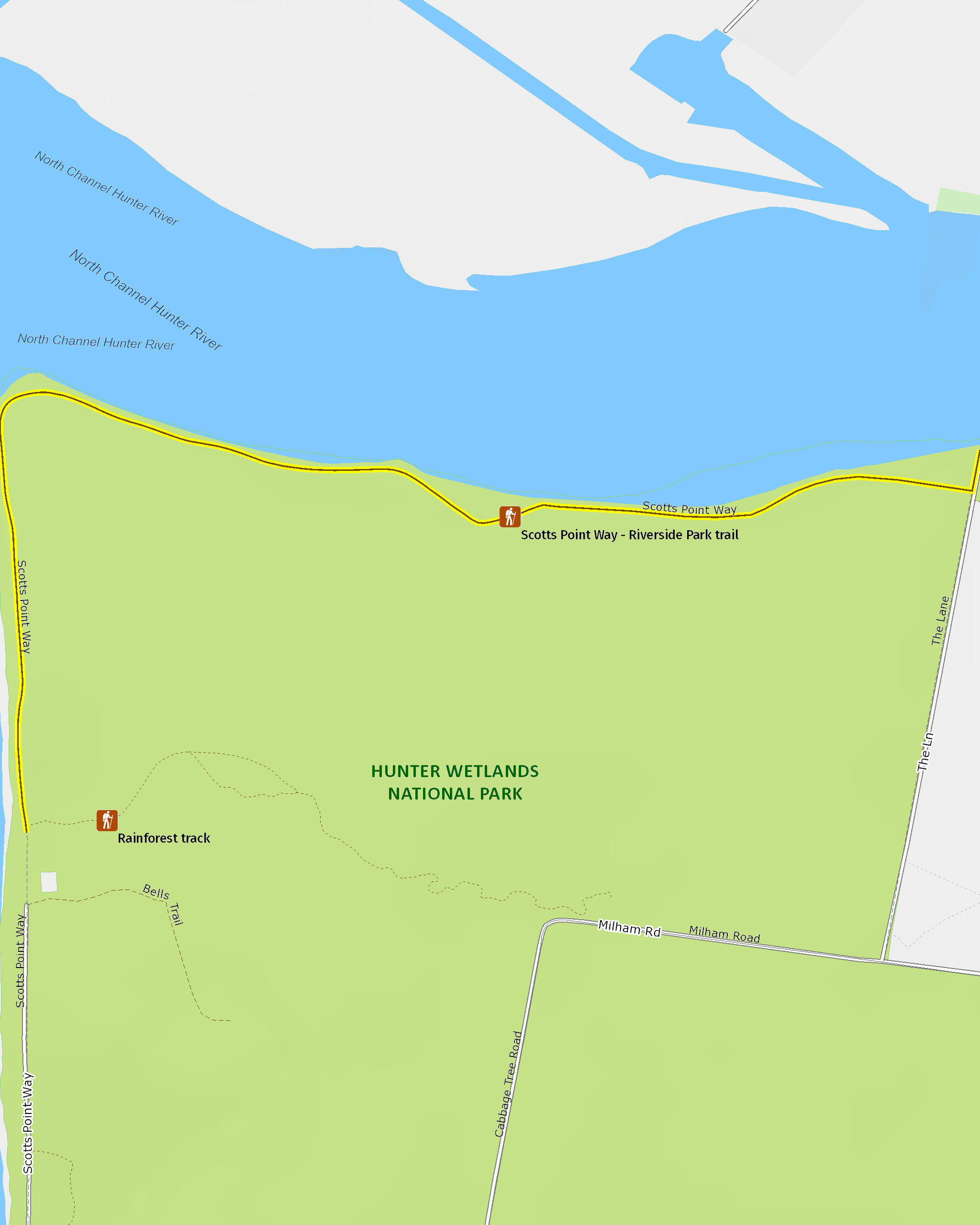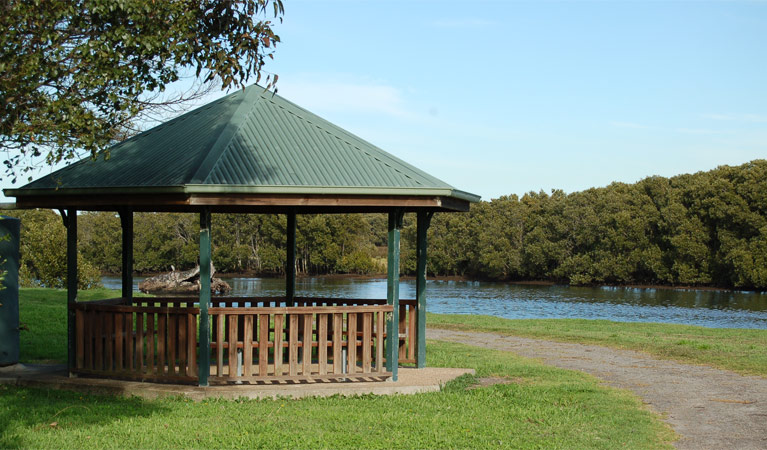Overview
Enjoy an easy walk or bike ride along the river on the Scott Point to Riverside Park trail, Ash Island, as it takes you past excellent spots for fishing and birdwatching.
- Where
- Hunter Wetlands National Park in North Coast
- Accessibility
- Medium
- Distance
- 1.4km one-way
- Time suggested
- 45min - 1hr 15min
- Grade
- Grade 2
- What to
bring - Drinking water, hat, sunscreen
- Please note
Remember to take your binoculars if you want to birdwatch.
Take a step back in history as well as a walk through nature. At the beginning of the Scotts Point to Riverside Park trail, you’ll find a visitor information shelter that shows some reproductions of 1860s botanical drawings by the Scott sisters, the daughters of one of the island’s first European settlers.
The trail follows the north arm of the Hunter River. It’s an easy walk or you can jump on a bike. There are two rest spots with picnic tables – one at Scotts Point and the other at your final destination, Riverside Park.
Once you’re there, you might want to get out your fishing line. There’s a jetty here – the only deepwater one between Newcastle and Raymond Terrace – that’s popular for recreational fishing.
If you’re an early riser, dawn around here is spectacular. The water is so still, it’s like a mirror, and the birds are actively fishing and foraging on the river foreshore.
Take a virtual tour of Scotts Point Way to Riverside Park trail captured with Google Street View Trekker.
Map

Map legend

Local alerts
For the latest updates on fires, closures and other alerts in this area, see https://www.nationalparks.nsw.gov.au/things-to-do/walking-tracks/scotts-point-way-to-riverside-park-trail/local-alerts
General enquiries
- National Parks Contact Centre
- 7am to 7pm daily
- 1300 072 757 (13000 PARKS) for the cost of a local call within Australia excluding mobiles
- parks.info@environment.nsw.gov.au
Park info
- in Hunter Wetlands National Park in the North Coast region
Hunter Wetlands National Park is always open but may have to close at times due to poor weather or fire danger.
Visitor info
All the practical information you need to know about Scotts Point Way to Riverside Park trail.
Track grading
Features of this track
Distance
1.4km one-way
Time
45min - 1hr 15min
Quality of markings
Clearly sign posted
Experience required
No experience required
Gradient
Flat
Steps
No steps
Quality of path
Well-formed track: The walk is 4m-wide and hard-packed ground with some wood vehicle bridges at points.
Other barriers
Gates: There are gates at the start and the end of the walk.
Other barriers:
- There are points on the track where grass has grown.
- After rain, some parts of the track may be boggy and muddy.
Getting there and parking
Get driving directions
Scotts Point to Riverside Park trail is in the Ash Island precinct of Hunter Wetlands National Park. To get there from Newcastle:
- From the Pacific Highway, turn onto the Ash Island Bridge.
- On the other side of the bridge, turn left and drive along Scotts Point Way.
- Park at the end of Scotts Point Way near the information sign
Parking
- Roadside parking is available if you're starting the walk at Scotts Point Way.
- There's a bitumen carpark if you're starting the walk from Riverside Park.
Best times to visit
There are lots of great things waiting for you in Hunter Wetlands National Park. Here are some of the highlights.
Autumn
With the weather mild, now is the time to get those bicycles out and ride the paths around Ash Island.
Spring
Pack a picnic to eat at Scotts Point or Riverside Park This is also the time you'll see the cream flowers of the mangroves .
Summer
This is the best time for birdwatching at Stockton Sandspit, as many of the migratory birds are here feeding. Make sure you're there at low-tide.
Weather, temperature and rainfall
Summer temperature
Average
20°C and 25°C
Highest recorded
42°C
Winter temperature
Average
10°C and 18°C
Lowest recorded
1.8°C
Rainfall
Wettest month
March
Driest month
November
The area’s highest recorded rainfall in one day
283.7mm
Facilities
Picnic tables
There are picnic tables at points along the walk.
Seats and resting points
There is a covered shelter at the bend in the walk with 3 benches.
Maps and downloads
Accessibility
Disability access level - medium
Scotts Point to Riverside Park trail is 4m-wide, flat and step-free. There are some areas where assistance may be required:
- There are gates at the start and the end of the walk
- There are points on the track where grass has grown.
- After rain, some parts of the track may be boggy and muddy.
There are flush toilets at the Riverside Park end of the track, but they're not accessible or ambulant.
Permitted
Fishing
A current NSW recreational fishing licence is required when fishing in all waters.
Prohibited
Pets
Pets and domestic animals (other than certified assistance animals) are not permitted. Find out which regional parks allow dog walking and see the pets in parks policy for more information.
Smoking
NSW national parks are no smoking areas.
Learn more
Scotts Point Way to Riverside Park trail is in Hunter Wetlands National Park. Here are just some of the reasons why this park is special:
All-ages adventure

The action all starts at Riverside Park. Here, you'll find a picnic area and paths leading off around Ash Island. They're all flat and wide, so perfect for getting kids on their bikes for some fresh air. Take a walk through the wetlands and identify different species of birds. Head to the deepwater jetty and do some fishing. There's quite the underwater bounty around here and, whether your spot is the jetty or the river foreshores, you can haul in flathead, whiting, tailor and bream.
- Rainforest walk to Riverside Park Rainforest walk to Riverside Park, near Newcastle, is suitable for walking or cycling and crosses Ash Island, ending by the river where you can fish and birdwatch.
- Riverside Park The family-friendly Riverside Park, near Newcastle, is the perfect base for cycling, walking, fishing and birdwatching on Ash Island.
- Scotts Point Way to Riverside Park trail Enjoy an easy walk or bike ride along the river on the Scott Point to Riverside Park trail, Ash Island, as it takes you past excellent spots for fishing and birdwatching.
Early evidence

Get a taste of some of the area's history. From the picnic area at Riverside Park, you can walk through the Kooragang City Farm precinct and find the ruins of the farmhouse and dairy built by William Milham, who ran a property here with the first European owner of Ash Island, AW Scott. Also on the island is a heritage-listed World War II radar 'igloo'.
- Rainforest walk to Riverside Park Rainforest walk to Riverside Park, near Newcastle, is suitable for walking or cycling and crosses Ash Island, ending by the river where you can fish and birdwatch.
- Scotts Point Way to Riverside Park trail Enjoy an easy walk or bike ride along the river on the Scott Point to Riverside Park trail, Ash Island, as it takes you past excellent spots for fishing and birdwatching.
Feather bluster

The Hunter River and its estuaries are home to a number of habitats - freshwater wetlands, mangroves and coastal rainforest among them - making the area a haven for birdlife. More than 200 species of birds live here or pass through on their migration. Head to Stockton Sandspit, where shorebirds - plovers, oystercatchers and curlews, to name a few - roost and feed on the mud flats. Along the river foreshore, you'll also likely see pelicans, spoonbills, black swans and, sweeping over the water searching for fish, sea eagles and swamp harriers.
- Guided kayak adventures at Smiths Island Spend a day exploring mangrove forests and islands by kayak on this tour of Hunter Wetlands National Park with the friendly guides from the School of Yak. It’s a great way to reconnect with nature in this birdwatchers’ paradise around Smiths Island.
- Junior ranger: Shorebirds and mangroves Calling all junior rangers, join us on a birdwatching adventure these school holidays! Bring your camera and see if you can photograph the shorebirds at Hunter Wetlands National Park, near Newcastle.
- The Earth's environment Did you know that over 10 per cent of NSW is a national park? That’s over 7 million hectares. This Stage 2 (Years 3-4) Geography excursion is delivered Hunter Wetlands National Park.
World-class wetlands

Hunter Wetlands National Park makes up part of the Hunter Estuary Wetlands Ramsar site (the Ramsar convention recognises wetlands of international importance). This peaceful area is important for many species of birds, including 45 that migrate internationally. The green and golden bell frogs, both threatened species, breed in the freshwater lagoons. The mangroves here also provide maternity roosts for tiny bats, including the eastern free-tail bat.
- Junior ranger: Shorebirds and mangroves Calling all junior rangers, join us on a birdwatching adventure these school holidays! Bring your camera and see if you can photograph the shorebirds at Hunter Wetlands National Park, near Newcastle.
- Rainforest walk to Riverside Park Rainforest walk to Riverside Park, near Newcastle, is suitable for walking or cycling and crosses Ash Island, ending by the river where you can fish and birdwatch.
- Riverside Park The family-friendly Riverside Park, near Newcastle, is the perfect base for cycling, walking, fishing and birdwatching on Ash Island.
Plants and animals protected in this park
Animals
-

Grey-headed flying-fox (Pteropus poliocephalus)
The grey-headed flying fox is Australia's largest native bat, with a wingspan up to 1m. This threatened species travels up and down south-eastern Australia and plays a vital role in pollinating plants and spreading seeds in our native forests.
-

Green and golden bell frog (Litoria aurea)
The green and golden bell frog is an endangered Australian frog. Once common on the NSW coast and tablelands, populations have plummeted around 90 percent.
Plants
-

Grey mangrove (Avicennia marina)
Grey mangrove is the most common and widespread mangrove found within intertidal zones across Australia, and throughout the world. Growing to a height of 3-10m, they thrive best in estuaries with a mix of fresh and salt water. They excrete excess salt through their long thick leaves, and absorb oxygen through their aerial root system.

